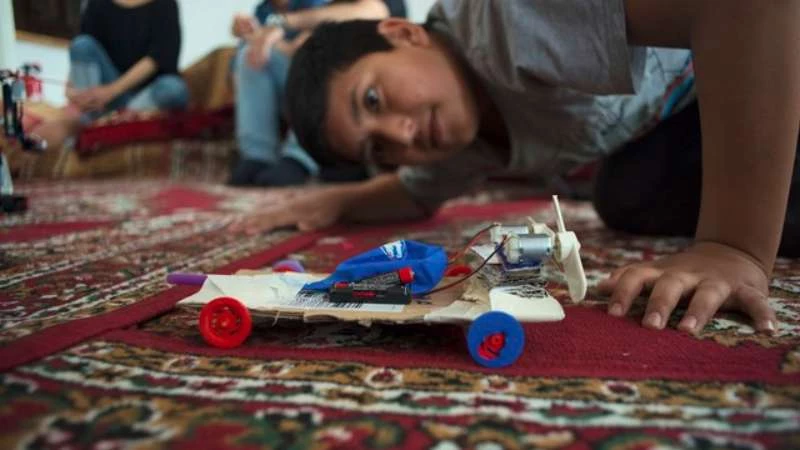Eleven-year-old Muna, who arrived from war-torn Aleppo, and two other children managed to build and program their robots in less than three days – a process that required them to follow 300 separate instructions. Muna guides her device using an interface inside a mobile telephone, testing to see if it can throw balls into a metal bowl. The automaton – named “Otto Miller” – throws the balls perfectly and she squeals with excitement.
Before becoming a volunteer teacher, Hasna was a promising mathematics student in Syria. When the war broke out, he decided to get involved in humanitarian aid and left his hometown of Qatana in rural Damascus in February 2013 to work as an ambulance driver. In April that same year a shell obliterated his ambulance and almost killed him. Though he was numb from pain at the time, due to the sudden rush of adrenaline upon contact, Hasna had lost his left leg below the knee and was bleeding profusely. He was rushed across the border to Jordan, where doctors were able to save his life. He was then taken to Zaatari refugee camp.
It was in Jordan that he first became acquainted with the “Maker Movement,” a group of people who believe that do-it-yourself solutions are critical to solving the technical and aesthetic needs of humankind. He began to spend time at the 3D lab run by an organization called Refugee Open Ware (ROW) at the camp. There, he designed and constructed his own prosthetic leg. He began to learn other uses for 3D fabrication and electronic engineering. Soon afterward, he designed and constructed a device that allowed a blind friend to sense the presence of approaching objects. “We live in a world today where you can essentially make what you can imagine,” he says. “I want to be a part of that future.”
Since arriving in Germany last year, Hasna has dedicated his time to teaching children the skills he’s learned. He’s happy to work as a volunteer teacher for the pilot project run by the ReDI School of Digital Integration. He envisions DIY technologies, 3D printing, electronics and computer programming as the tools that will help to integrate a young generation of refugees into German society. “Building and programming teaches the kids problem-solving,” he says. “They’re learning the skills they will need in the future.”
Hasna hopes that teaching technology will do more than just divert children away from the traumas of the past. He and others at the school believe that refugees are resourceful, valuable individuals who must be trained for the economies of the future. In Germany alone there are 43,000 job openings in various sectors of the technology sector.
At the ReDI, courses are also taught to young adults on topics such as database management, app development and programming. “If we look at the skill sets that you need in the 21st century, there is no doubt that we are becoming more digital and that the economy is increasingly global. We need people who can build bridges” says Anne Kjaer Riechert, managing director of the school.
“We see refugees as street-smart, resilient and risk-taking people. If we get things right, they are pioneers who can become valuable resources for Europe, socially, culturally as well as financially,” she concludes.



التعليقات (0)